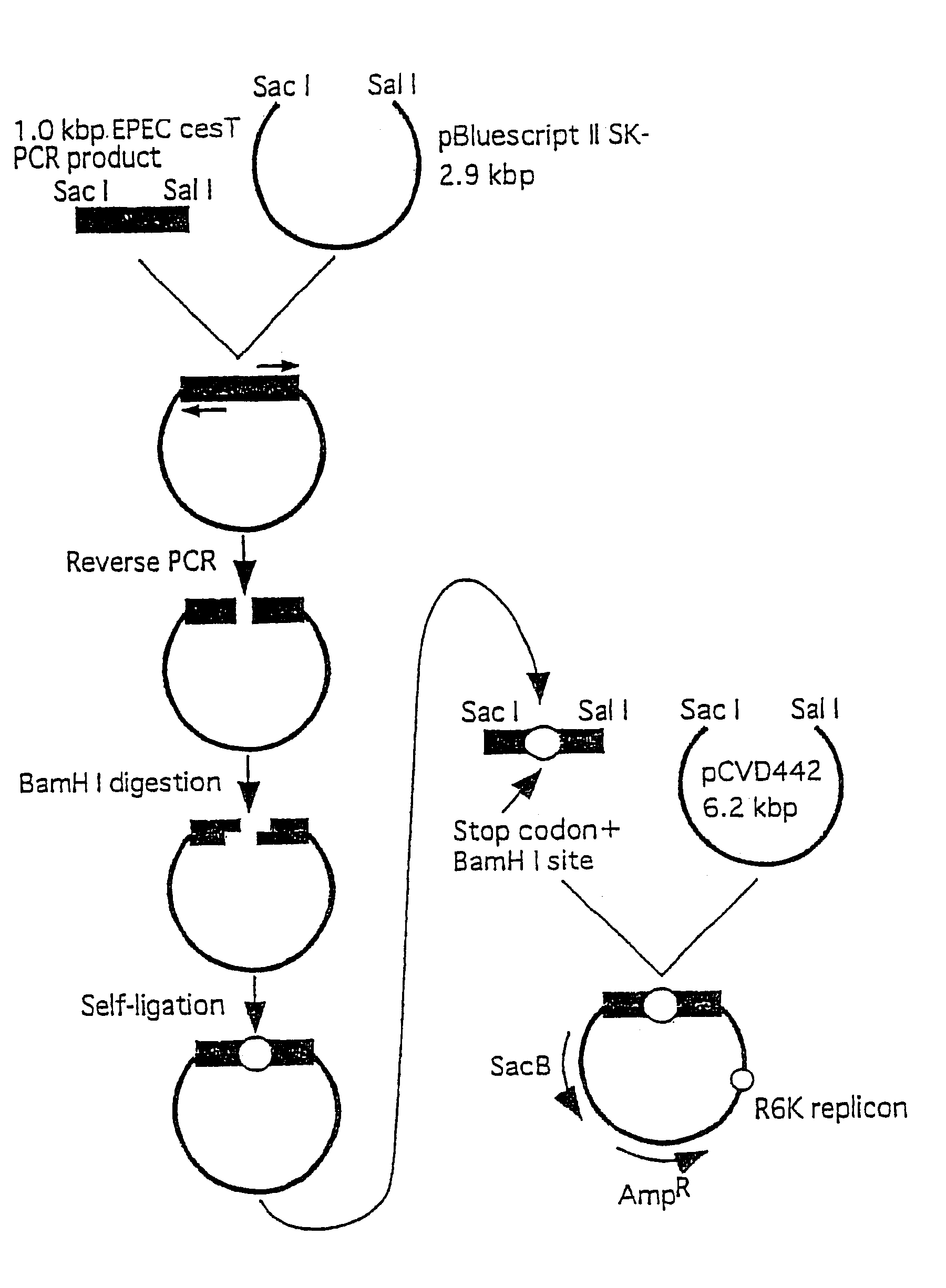Method for detecting substances inhibiting the bacterial type III secretion mechanism and function of secretory proteins thereof
a secretion mechanism and protein technology, applied in the field of methods for detecting substances inhibiting the bacterial type iii secretion mechanism and the function of secretory proteins thereof, can solve the problems of difficult treatment of large numbers of test samples within short time, no methods for detecting substances, and complex operations
- Summary
- Abstract
- Description
- Claims
- Application Information
AI Technical Summary
Benefits of technology
Problems solved by technology
Method used
Image
Examples
referential example 1-1
EPEC cesT defective strain: Tir specific chaperone defective strain (Molecular Microb. 33, 1162-1175, 1999); obtainable from Dr. Abe, Akio, The Kitasato Institute, 9-1, Shirokane 5-chome, Minato-ku, Tbkyo, Japan
Preparation of defective strain was performed by previously established procedure (Molecular Micro. 33, 1162-1175, 1999. FIG. 1 shows outlines of plasmid construction used for preparation of EPEC cesTdeficient strain. FIG. 2 shows a primer set for amplification of the gene used for the recombinant plasmid construction. FIG. 3 shows a primer set for inserting a terminal codon and BamHI site by reverse PCR which is used for the recombinant plasmid construction.
Preparation of a Recombinant Plasmid Used for Obtaining EPEC cesT defective Strain
EPEC E2348 / 69 chromosomal DNA 0.5 .mu.g was added to a solution 100 .mu.l of 25 mM TAPS buffer (pH 9.3, 25.degree. C.), 50 mM KCl, 2 mM MgCl.sub.2, 1 mM 2-mercaptoethanol, 0.2 mM dNTP, 0.5 .mu.M primer set (refer to FIG. 2) and 2.5 units Tak...
referential example 1-2
EPEC sepB Defective Strain
EPEC sepB defective strain: a strain lacking type III secretory mechanism (Proc. Natl. Acad. Sci., USA 92, 7996-8000, 1995; obtainable from Center for Vaccine Development and Department of Microbiology and Immunology, University of Maryland School of Medicine, U.S.A., Dr. James B. Kaper).
Preparation of Recombinant Plasmid Used for Obtaining EPEC sepB Defective Strain
FIG. 4 shows a construction of a recombinant plasmid used for preparation of EPEC sepB defective strain. FIG. 5 shows a primer set for amplifying gene used for the construction of the recombinant plasmid. FIG. 6 shows a primer set for inserting a termination codon and a BglII site by the reverse PCR used for construction of the recombinant plasmid.
EPEC E2348 / 69 chromosomal DNA 0.5 .mu.g was added to a solution 100 .mu.l of 25 mM TAPS buffer (pH 9.3, 25.degree. C.), 50 mM KCl, 2 mM MgCl.sub.2, 1 mM 2-mercaptoethanol, 0.2 mM dNTP, 0.5 .mu.M primer set (refer to FIG. 5) and 2.5 units Takara EX Taq ...
referential example 1-3
EPEC espa Defective Strain
EPEC espa defective strain: a strain lacking type III secretory protein espA (Molecular Microb., 20, 313-323, 1996; obtainable from Biotechnology Laboratory, University of British Columbia, Canada, Dr. B. Brett Finlay or Dr. Abe, Akio, The Kitasato Institute, Sirokane 5-9-1, Minato-ku, Tokyo, Japan.
Preparation of Recombinant Plasmid Used for Obtaining EPEC espA Defective Strain
FIG. 7 shows a construction of a plasmid used for preparation of EPEC espa defective strain. FIG. 8 shows a primer set for amplifying gene used for the construction of the recombinant plasmid. FIG. 9 shows a primer set for inserting a termination codon and a BglII site by the reverse PCR used for construction of the recombinant plasmid.
EPEC E2348 / 69 chromosomal DNA 0.5 .mu.g was added to a solution 100 .mu.l of 25 mM TAPS buffer (pH 9.3, 25.degree. C.), 50 mM KCl, 2 mM MgCl.sub.2, 1 mM 2-mercaptoethanol, 0.2 mM dNTP, 0.5 .mu.M primer set (refer to FIG. 8) and 2.5 units Takara EX Taq (...
PUM
| Property | Measurement | Unit |
|---|---|---|
| pH | aaaaa | aaaaa |
| pH | aaaaa | aaaaa |
| pH | aaaaa | aaaaa |
Abstract
Description
Claims
Application Information
 Login to View More
Login to View More - R&D
- Intellectual Property
- Life Sciences
- Materials
- Tech Scout
- Unparalleled Data Quality
- Higher Quality Content
- 60% Fewer Hallucinations
Browse by: Latest US Patents, China's latest patents, Technical Efficacy Thesaurus, Application Domain, Technology Topic, Popular Technical Reports.
© 2025 PatSnap. All rights reserved.Legal|Privacy policy|Modern Slavery Act Transparency Statement|Sitemap|About US| Contact US: help@patsnap.com



